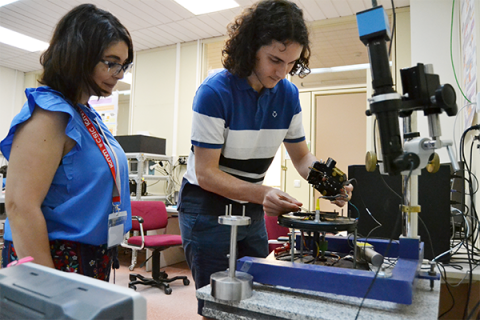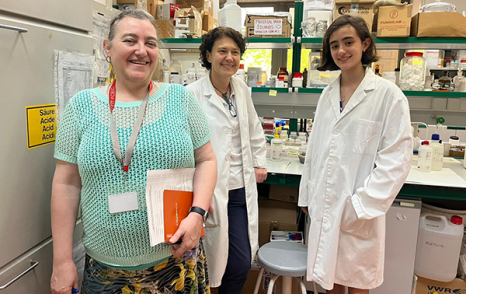The ICMM welcomes gifted students to support their science education

The Materials Science Institute of Madrid (ICMM-CSIC), in its commitment to making scientific dissemination and education more inclusive, has formalized its participation in support programs for gifted individuals to aid in their science education this year. Thanks to this, Raúl Martínez and Laura Azzimonti have enjoyed unique stays at the center.
"I feel lucky to have had this opportunity," says Raúl, who spent the entire month of June learning from Miriam Jaafar thanks to the Max Mazin Foundation. With this researcher, the young man, who is in his first year of Physics at the Autonomous University of Madrid, has learned about the research and work in the field of nanomagnetism: "We worked with the Atomic Force Microscope (AFM): he learned how the technique works by studying the configuration of different hard drives and put this knowledge into practice with various systems, from thin films to nanowires," Jaafar describes. "The truth is, his ability to grasp all the concepts is astonishing," she assures.
The young says: "Although I still have several years of undergraduate and master's studies ahead, this experience is helping me get an idea of, for example, everything that can be studied with an AFM, and other techniques," he describes. In fact, he confesses that he is already considering which techniques might be useful when choosing and planning his Bachelor's or even Master's thesis. "Talking to people who have already been where I am going is useful; it lights up the path a bit. It is helping me to get an idea of what to expect from the world of research," he points out.

Laura Azzimonti, on the other hand, is from Galicia and spent time at the ICMM-CSIC thanks to the San Patricio Foundation. She spent three days in Pilar Aranda's group, discovering what hybrid materials are and all their derivatives. "I had never worked on these concepts before, and although I am now going to study Physics, I think they will be very useful," the young woman commented while practicing in one of the laboratories.
"Laura had the opportunity to learn about both aspects related to research in different types of materials and some characterization methodologies," explains Aranda. Among other things, the team showed her examples of some of the materials they work with: superparamagnetic iron oxide nanoparticles, pigments like Prussian blue, porous materials, and films based on metallic oxide particles and biopolymers.
The young woman was also able to appreciate different types of microscopes: "She observed liquid crystals using optical microscopy with polarized light and also had the chance to see how a field-emission scanning electron microscope (FE-SEM) works and what it is used for; she even managed to handle it to adjust images," Pilar Aranda explains.
Both these researchers and the rest of their teams are pleased with the experience and are looking forward to repeating it: "Their ability to grasp concepts is astonishing," concludes Jaafar.
Instituto de Ciencia de Materiales de Madrid (ICMM)
Sor Juana Ines de la Cruz, 3
Cantoblanco, 28049
Madrid, España
Telephone: (+34) 91 334 90 00
Email: @email
Communication Office: @email

Acknowledge the Severo Ochoa Centres of Excellence program through Grant CEX2024-001445-S/ financiado por MICIU/AEI / 10.13039/501100011033

Contacto | Accesibilidad | Aviso legal | Política de Cookies | Protección de datos